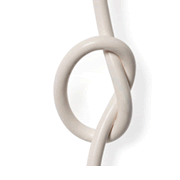- Birth control
- Sterilization
- Tubal ligation
Tubal ligation

What is tubal ligation (getting your tubes tied)?
Tubal ligation is a super-effective, permanent birth control method (also called sterilization) for people with vaginas. It’s a surgery that you can do immediately after giving birth or at any other time. The procedure closes your fallopian tubes, which normally carry eggs from your ovaries to your uterus. Your fallopian tubes are also where fertilization happens. Fertilization occurs when sperm meets an egg in one of your fallopian tubes, so closing off the fallopian tubes means that sperm can’t reach the eggs.
There are a few different ways that fallopian tubes can be closed off, and they can also be fully removed, which decreases the chances of ovarian cancer (which often begins in the fallopian tubes). Tubal ligation does NOT involve removing the ovaries, so your hormones will not be changed by the procedure.
There are two types of tubal ligation procedures out there—laparoscopy and mini-laparotomy. Because these methods involve a surgical procedure, you’ll need some type of anesthesia for either one. Recovery times vary from one or two days to a few weeks.
While it is sometimes possible to reverse tubal ligation if part of the fallopian tubes are left in your body, it’s a difficult process that can be very expensive, and there is no guarantee that you’ll be able to get pregnant afterward. In-vitro fertilization is possible after tubal ligation but it can also be very expensive, it’s often not covered by insurance, and it’s also not guaranteed to end in pregnancy. It’s best to plan for tubal ligation to be permanent.
Quick Facts
-
Effectiveness
Tubal ligation is super effective—it’s one of the most effective ways to prevent pregnancy.
Perfect use: Over 99% effective
Typical use: Over 99% effective
What are perfect use and typical use?
-
Hormones
Sterilization is hormone-free.
-
Side effects
Possible pain or discomfort right after the procedure.
-
Cost
As low as $0 (with insurance) or as high as $6,000.
-
STI protection
Tubal ligation doesn’t protect against STIs.
-
Ongoing effort
Nothing you have to do once the procedure is done.
Tubal ligation may be right for you if…
Effectiveness at preventing pregnancy is a top priority for you.
Tubal ligation is over 99% effective at preventing pregnancy. That means fewer than one out of every 100 people who have had tubal ligation will get pregnant over the course of a year.
You want birth control without hormones.
If you are looking for super effective pregnancy prevention but don’t want to use hormones, tubal ligation may be a good option for you.
You don’t want to have to remember anything for your birth control to work.
Tubal ligation is great if you don’t want to worry about taking a pill every day, switching out a ring or patch, or putting on a condom every time you have sex. Once you have the procedure, there’s nothing else for you to do—you’ve got birth control for life.
You still want to get a period.
If you’re currently getting a period and you want birth control that won’t change that, sterilization may be an option for you. Because your ovaries aren’t removed when you get tubal ligation, your hormones are not affected by the procedure, so your period won’t be affected either.
You aren’t looking for STI protection, or you’re okay with combining tubal ligation with another method.
While tubal ligation protects against pregnancy, it doesn’t offer any STI protection. So if that’s something you’re looking for, you can use condoms or internal condoms along with getting tubal ligation. Dental dams and/or gloves also offer STI protection, depending on what kind of sex you’re having. You may also want to consider PrEP (pre-exposure prophylaxis), which is a daily pill or an injection you can get every two months to decrease your risk of getting HIV.
You’re sure you don’t want to get pregnant at any time in the future.
Maybe you never wanted to have kids, and you still don’t. Maybe you feel like your family is complete with the kids you already have. Or maybe getting pregnant would put your health at risk, and you want to make sure to avoid it. Tubal ligation may be a good option in these situations.
You don’t mind a method that requires a visit to your health care provider.
Because tubal ligation is a surgical procedure, you will need to see a health care provider to have it done.
How does tubal ligation work?
There are two main ways that tubal ligations are done: mini-laparotomy and laparoscopy. Both are effective at preventing pregnancy immediately, but it can take time to recover.
Mini-laparotomy is commonly done right after you’ve given birth, before any anesthesia from delivery has worn off. If you’ve had a vaginal birth (delivered your baby through your vagina), your provider will make a small incision (cut) in your lower abdomen and will close off your tubes, remove part of them, or remove them entirely. If you’ve had a c-section, your provider will use the same incision they used to deliver your baby.
Laparoscopy is more involved and may have a longer recovery period than mini-laparotomy. Some people need to recover in the hospital for a couple of days. With a laparoscopy, a few incisions are made in your abdomen. A bigger incision than you’d have with a mini-laparotomy is made near your belly button and a tiny camera called a laparoscope is inserted along with very small surgical tools. The laparoscope lets the doctor see your fallopian tubes so they can close them off using the tools. The doctor will close the incisions on your abdomen, and you’ll be protected from pregnancy right away.
How much does tubal ligation cost?
With insurance
If you have health insurance—whether it’s from work, school, your parents, the ACA marketplace, or Medicaid—chances are good that you’ll be able to get tubal ligation with no out-of-pocket cost.
Without insurance
If you don’t have insurance or if you’re on a plan that doesn’t cover birth control, tubal ligation can be pricey up front—up to $6,000. Still, sterilization lasts forever, so compared to other methods that you have to pay for repeatedly, it may end up being cheaper over time.
It may also help to shop around a little. The price for surgical procedures like sterilization in the U.S. can vary a lot from one provider to another. You can call different clinics and hospitals in your area to find the lowest price and ask about assistance programs for those who qualify. Some hospitals and health centers may offer assistance to patients who don’t earn a lot of money, but make too much to qualify for Medicaid. Contact the reproductive health departments at nearby hospitals and clinics to find out if assistance is available. You can also ask about Title X funding, Medicaid waivers, or other programs that could reduce the cost of sterilization.
What are the side effects and benefits of tubal ligation?
There are positive and negative things to say about every method. And everyone’s different—so what you experience may not be the same as what someone else experiences.
The Positive
There are lots of things about birth control that are good for your body as well as your sex life. Here are some of the benefits of tubal ligation:
- Your method will work for the rest of your life.
- It’s hormone-free.
- It’s extremely effective at preventing pregnancy.
- Tubal ligation can reduce the risk of ovarian cancer if your fallopian tubes are removed completely.
The Negative
It’s normal to worry about negative side effects, but for many people, they’re not a problem. Potential side effects include:
- There is very small risk that your tubes may reconnect themselves, which could allow you to get pregnant.
- While the risk of ectopic pregnancy is low because the risk of pregnancy is low, if you do get pregnant after tubal ligation, the risk of it being an ectopic pregnancy is high.
- There could be complications with surgery, like bleeding, infection or a reaction to anesthesia.
In addition to potential side effects, it’s important to keep in mind that tubal ligation is very difficult or impossible to undo.
Where can you get tubal ligation?
Tubal ligation is available at many family planning clinics, hospitals, and private practices. Find a health center near you.

We can help you find an in person provider or online birth control delivery service.
find health care